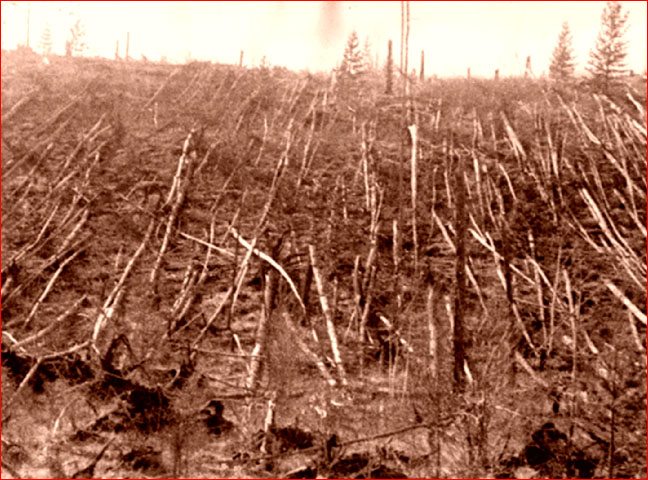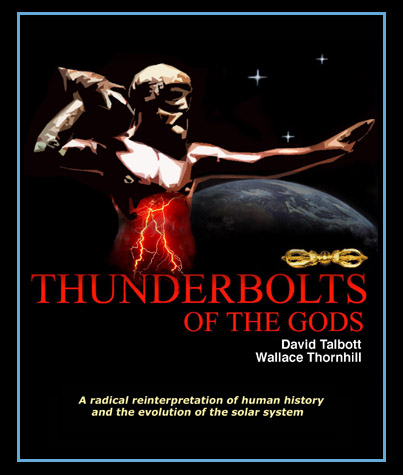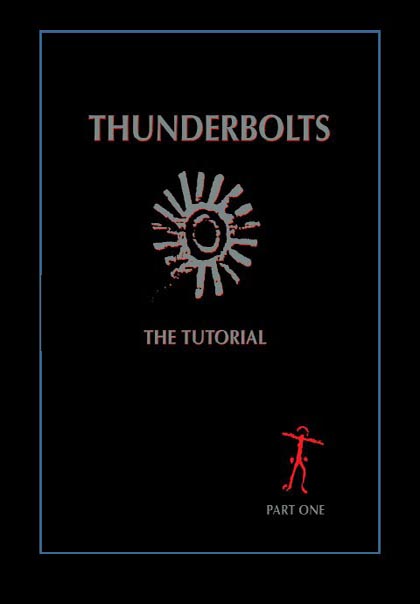
home •
about •
essential guide •
picture of the day •
thunderblogs •
news •
multimedia •
predictions •
products •
get involved •
contact

Pictures such as this, taken by the Leonid Kulik expedition in 1930,
show the directional fall of trees over a wide area.
pic of the day
archive
subject index
abstract
archive
Links:
Society for
Interdisciplinary
Studies

Thunderbolts of the Gods is a
108 page 8-1/2 x 11 full color monograph based on the life work of the two
authors--a revolutionary synthesis of comparative mythology and the
newly-discovered "Electric Universe".

The Monograph includes
an hour-long DVD introducing various aspects of the Electric
Universe explained by members of the Thunderbolts Group.
Feb 03, 2006
The Tunguska Event
(2)
An Explanation that Works
It seems that scientific investigation has left the mystery of the fiery Tunguska explosion unresolved. From the beginning, the debate excluded the electric force, the one force that allows for a unified solution and excludes no field of evidence.
Proponents of the “Electric Universe” ask that this new perspective on the physical world be judged by its predictive ability, its ability to explain all relevant data. In accounting for the Tunguska event they insist that, unlike prior “explanations”, the Electric Universe does not leave a substantial body of evidence unexplained.
The extraordinary power of the high-energy explosion above ground.
The most likely origin of the object that caused the Tunguska event is the short-period comet Encke, the acknowledged source of the Beta Taurid meteor shower. On June 30, the shower was at its peak. In the electric model of comets, the energy released when a comet fragment encounters the Earth is not limited by the mass and kinetic energy of the fragment, but includes the electrical energy due to the charge differential between it and the Earth. This stored electrical energy also accounts for the “astonishing” explosion that occurred when the Deep Impact probe met up with Comet Tempel 1. Calculations of the mass and size of the Tunguska bolide, based solely on mechanical considerations, will be exaggerated. This, of course, has implications when searching for fragments that survived the fall.
Repeated testimony of strange sounds before the event.
In terms of the speed of sound in Earth’s atmosphere, the reports of weird sounds in advance appear absurd. But they are entirely plausible as "electrophonic sounds" heard either before, or simultaneous with, the sighting of brilliant meteor fireballs up to 100km distant. Electrophonic sounds signify the direct conversion, by transduction, of very low frequency electromagnetic energy into audible sounds (through a medium that can be as simple as a gold tooth filling or a pair of glasses). Abundant reports of peculiar sounds in connection with meteors, auroras, earthquakes and even nuclear bomb tests are sufficient to substantiate the effect. The cause is most easily understood as a natural resonance of an extensive plasma discharge in the Earth's atmosphere (or underground in the case of earthquakes). In the case of an approaching comet, the incoming body is electrified with respect to the Earth.
The glowing of the sky before the event.
In the electric solar system, the planets and all comets have plasma sheaths that isolate them electrically from the solar plasma. When two plasma sheaths "touch", the two bodies "see" each other electrically for the first time. Comets have plasma sheaths that are millions of kilometers in diameter. So even at their high speed their electrical effect could be felt days in advance of a physical encounter. In such instances, the electrical effect upon the Earth may take the form of unusual auroral displays. The prior “sky glows” associated with Tunguska could also be due to cometary fragments, lying along the comet's orbit in advance of the comet nucleus, entering the stratosphere and reflecting sunlight long after sunset. Of course, a simple “asteroidal” explanation of Tunguska cannot address either this phenomenon, or any of the other advanced signs of the intruder’s approach (noted below).
Reports of strange weather before the event.
In an electric solar system electric currents flowing between the solar plasma and the planets are the primary factors driving Earth’s weather patterns. In fact, the most violent winds occur on planets most distant from the Sun, where solar heating is negligible. Ice-cold Neptune, the gas giant farthest from Earth, has 2,000 km/h winds! When seen in these terms, it becomes clear that an electrical disturbance might be evident in the form of unusual weather days before the arrival of a comet.
Reports of strange seismic activity before the event.
New evidence links earthquakes to the occurrence of "underground lightning." A minor electrical disturbance of the Earth, due to the intrusion of a charged body, could indeed trigger earthquakes, in the same way that electrical sunspot activity influences earthquakes.
Geomagnetic effects before the event.
Professor Weber of Kiel University observed unusual regular periodic deviations of the compass needle. This effect was repeated each evening from 27 June through 30 June 1908. The recordings looked like geomagnetic storms, usually associated with solar electrical activity. This time the approaching comet was the most likely source of the electrical disturbance. The duration of the storms indicates that comets are a copious source of electrons. That is, comets are highly negatively charged with respect to the inner solar system. Their influence can be vastly greater than mere gravitational and inertial considerations would suggest.
Global atmospheric pressure pulse.
The Earth’s atmosphere forms the dielectric of a capacitor with the two "plates" of the capacitor being the Earth and the ionosphere. The comet's electrical disturbance will cause pressure pulses in the atmosphere before the comet arrives as well as upon arrival. It is noteworthy in this respect that a giant ionospheric disturbance accompanied the magnitude 9.3 Sumatra earthquake of 26 December 2004. The ionosphere moved up and down by about 40 km! And changes in the ionosphere have been registered 5 to 10 days before an earthquake.
Missing crater.
At a comet’s closest approach, a plasma discharge takes place between the Earth and the comet. The comet is fragmented explosively by internal electrical stresses, and all of the fragments may be melted or vaporized in a plasma discharge so that no impact crater is formed. An interesting fact is that the Tunguska epicenter almost exactly coincides with the muzzle of a Triassic volcano. Volcanoes are the focus of electric discharge activity and may retain an electrical conductivity different from that of the surrounding crust. This fact can only accentuate the argument that the blast was electrical.
Absence of meteoric fragments.
If we had to rely on the fireball and air friction alone to heat the bolide or to break it apart, we should expect to find stony remnants. However, as noted above, most or all of the comet fragments will be melted and vaporized in the plasma discharge. Also, "ground zero" is the focus of the plasma discharge between the Earth and the comet. It is not the site of any impact and we should not expect to find cometary fragments there.
Instantaneous eruption of fire across hundreds of square kilometers.
The plasma discharge between the comet and the Earth would have had many strange effects in the atmosphere and at ground level unlike anything ever experienced by the inhabitants. In addition to fires started by radiation from the fireball, electrically ignited fires would have been started at the same instant over a wide area.
Frightful lightning and thunder in the midst of the firestorm.
Unusual lightning, such as St. Elmo's fire and ball lightning would have been generated at the Earth's surface. Lightning would have struck from a clear blue sky. (See addendum to this discussion below.)
Blast of heat along with a shock wave many kilometers away from the explosion.
Wherever the discharges touch down there will be sudden heating of the air and a blast. Touchdown points may be a considerable distance from the bolide's track and the explosion center.
Presence of microscopic glassy spherules over a large area.
The final result of the explosive fragmentation, melting and vaporization of the bolide will be a spray of glassy spherules beyond the point where the main plasma discharge and explosion took place. The creation of spherules by electric discharge and electrical fusing, a common effect of lightning, is now well demonstrated in the laboratory.
Almost 100 years after the event, the specialists are still debating whether the exploding object was a comet or an asteroid. Conventional proponents of the comet explanation note the presence of cometary material in the ground over a wide area. Proponents of the asteroid or meteor hypothesis say that a fragile comet would be destroyed too high in the atmosphere. The debate is entirely irrelevant from an electrical vantage point. Comets, asteroids, and meteors have the same origins and are formed in the same way. It is the contemporary mythology of comets that suggests they are fragile "icy dirtballs." An asteroid large enough to hold its charge while moving on a highly elliptical (comet-like orbit) through the Sun’s electric field, would become a comet irrespective of its composition. In fact, we have an instance of this occurring when the asteroid Chiron, on a chaotic orbit between Saturn and Uranus, unexpectedly sported a tail and became classified as a comet.
In considering theories of the Tunguska event, certain questions must be asked without prejudice. Does a proposed explanation address all of the facts? Are the facts predictable under the proposed explanation? Is there anything we should expect to find that has not been found? The electric theorists are confident that, if official science will withdraw its investment in a discredited, electrically sterile view of the physical universe, the answers to these questions will be obvious.
ADDENDUM
In the case of the Tunguska event, some of the most compelling evidence comes from those who experienced the terror first hand. In 1928, I. M. Suslov recorded the following testimony from a member of Shanyagir tribe (this taken from the Wikipedia site)—
“We had a hut by the river with my brother Chekaren. We were sleeping. Suddenly we both woke up at the same time. Somebody shoved us. We heard whistling and felt strong wind. Chekaren said, "can you hear all those birds flying overhead?" We were both in the hut, couldn't see what was going on outside. Suddenly, I got shoved again, this time so hard I fell into the fire. I got scared. Chekaren got scared too. We started crying for out father, mother, brother, but no one answered.
“There was noise beyond the hut, we could hear trees falling down. Me and Chekaren got out of our sleeping bags and wanted to run out, but then the thunder struck. This was the first thunder. The Earth began to move and rock, wind hit our hut and knocked it over. My body was pushed down by sticks, but my head was in the clear. Then I saw a wonder: trees were falling, the branches were on fire, it became mighty bright, how can I say this, as if there was a second sun, my eyes were hurting, I even closed them. It was like what the Russians call lightning. And immediately there was a loud thunderclap. This was the second thunder. The morning was sunny, there were no clouds, our Sun was shining brightly as usual, and suddenly there came a second one!
Me and Chekaren had some difficulty getting under from the remains of our hut. Then we saw that above, but in a different place, there was another flash, and loud thunder came. This was the third thunder strike. Wind came again, knocked us off our feet, struck against the fallen trees.
“We looked at the fallen trees, watched the tree tops get snapped off, watched the fires. Suddenly Chekaren yelled "Look up" and pointed with his hand. I looked there and saw another flash, and it made another thunder. But the noise was less than before. This was the fourth strike, like normal thunder.
“Now I remember well there was also one more thunder strike, but it was small, and somewhere far away, where the Sun goes to sleep”.
EXECUTIVE EDITORS:
David Talbott, Wallace Thornhill
MANAGING EDITOR:
Michael Armstrong
CONTRIBUTING EDITORS: Dwardu Cardona, Ev Cochrane,
C.J. Ransom, Don Scott, Rens van der Sluijs, Ian Tresman
WEBMASTER: Michael Armstrong
Copyright 2006: thunderbolts.info